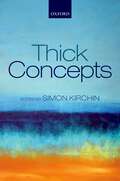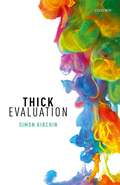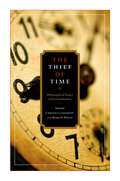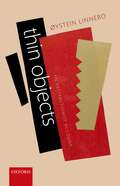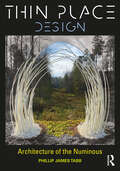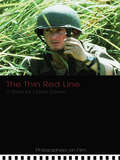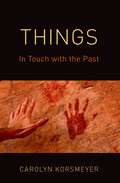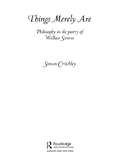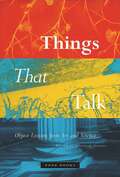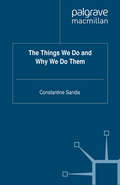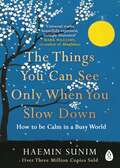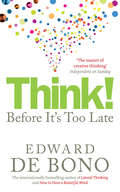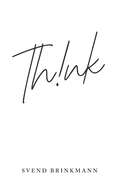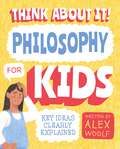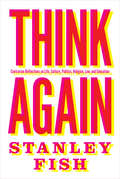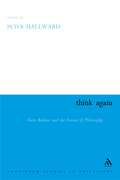- Table View
- List View
Thick Concepts (Mind Association Occasional Series)
by Simon KirchinWhat is the difference between judging someone to be good and judging them to be kind? Both judgements are typically positive, but the latter seems to offer more description of the person: we get a more specific sense of what they are like. Very general evaluative concepts (such as good, bad, right and wrong) are referred to as thin concepts, whilst more specific ones (including brave, rude, gracious, wicked, sympathetic, and mean) are termed thick concepts. In this volume, an international team of experts addresses the questions that this distinction opens up. How do the descriptive and evaluative functions or elements of thick concepts combine with each other? Are these functions or elements separable in the first place? Is there a sharp division between thin and thick concepts? Can we mark interesting further distinctions between how thick ethical concepts work and how other thick concepts work, such as those found in aesthetics and epistemology? How, if at all, are thick concepts related to reasons and action? These questions, and others, touch on some of the deepest philosophical issues about the evaluative and normative. They force us to think hard about the place of the evaluative in a (seemingly) nonevaluative world, and raise fascinating issues about how language works.
Thick Evaluation
by Simon KirchinThis is an open access title available under the terms of a CC BY-NC-ND 4.0 International licence. It is free to read at Oxford Scholarship Online and offered as a free PDF download from OUP and selected open access locations. We use evaluative terms and concepts every day. We call actions right and wrong, teachers wise and ignorant, and pictures elegant and grotesque. Philosophers place evaluative concepts into two camps. Thin concepts, such as goodness and badness, and rightness and wrongness have evaluative content, but they supposedly have no or hardly any nonevaluative, descriptive content: they supposedly give little or no specific idea about the character of the person or thing described. In contrast, thick concepts such as kindness, elegance and wisdom supposedly give a more specific idea of people or things. Yet, given typical linguistic conventions, thick concepts also convey evaluation. Kind people are often viewed positively whilst ignorance has negative connotations. The distinction between thin and thick concepts is frequently drawn in philosophy and is central to everyday life. However, very few articles or books discuss the distinction. In this full-length study, Simon Kirchin discusses thin and thick concepts, highlighting key assumptions, questions and arguments, many of which have gone unnoticed. Kirchin focuses in on the debate between 'separationists' (those who think that thick concepts can be separated into component parts of evaluative, often very 'thin', content and nonevaluative content) and 'nonseparationists' (who deny this). Thick Evaluation argues for a version of nonseparationism, and in doing so argues both that many concepts are evaluative and also that evaluation is not exhausted by thin positive and negative stances.
Thick Evaluation
by Simon KirchinThis is an open access title available under the terms of a CC BY-NC-ND 4.0 International licence. It is free to read at Oxford Scholarship Online and offered as a free PDF download from OUP and selected open access locations. We use evaluative terms and concepts every day. We call actions right and wrong, teachers wise and ignorant, and pictures elegant and grotesque. Philosophers place evaluative concepts into two camps. Thin concepts, such as goodness and badness, and rightness and wrongness have evaluative content, but they supposedly have no or hardly any nonevaluative, descriptive content: they supposedly give little or no specific idea about the character of the person or thing described. In contrast, thick concepts such as kindness, elegance and wisdom supposedly give a more specific idea of people or things. Yet, given typical linguistic conventions, thick concepts also convey evaluation. Kind people are often viewed positively whilst ignorance has negative connotations. The distinction between thin and thick concepts is frequently drawn in philosophy and is central to everyday life. However, very few articles or books discuss the distinction. In this full-length study, Simon Kirchin discusses thin and thick concepts, highlighting key assumptions, questions and arguments, many of which have gone unnoticed. Kirchin focuses in on the debate between 'separationists' (those who think that thick concepts can be separated into component parts of evaluative, often very 'thin', content and nonevaluative content) and 'nonseparationists' (who deny this). Thick Evaluation argues for a version of nonseparationism, and in doing so argues both that many concepts are evaluative and also that evaluation is not exhausted by thin positive and negative stances.
The Thief of Time: Philosophical Essays on Procrastination
by Chrisoula Andreou Mark D. WhiteWhen we fail to achieve our goals, procrastination is often the culprit. But how exactly is procrastination to be understood? It has been described as imprudent, irrational, inconsistent, and even immoral, but there has been no sustained philosophical debate concerning the topic. This edited volume starts in on the task of integrating the problem of procrastination into philosophical inquiry. The focus is on exploring procrastination in relation to agency, rationality, and ethics-topics that philosophy is well-suited to address. Theoretically and empirically informed analyses are developed and applied with the aim of shedding light on a vexing practical problem that generates a great deal of frustration, regret, and harm. Some of the key questions that are addressed include the following: How can we analyze procrastination in a way that does justice to both its voluntary and its self-defeating dimensions? What kind of practical failing is procrastination? Is it a form of weakness of will? Is it the product of fragmented agency? Is it a vice? Given the nature of procrastination, what are the most promising coping strategies?
The Thief of Time: Philosophical Essays on Procrastination
by Mark D. White Chrisoula AndreouWhen we fail to achieve our goals, procrastination is often the culprit. But how exactly is procrastination to be understood? It has been described as imprudent, irrational, inconsistent, and even immoral, but there has been no sustained philosophical debate concerning the topic. This edited volume starts in on the task of integrating the problem of procrastination into philosophical inquiry. The focus is on exploring procrastination in relation to agency, rationality, and ethics-topics that philosophy is well-suited to address. Theoretically and empirically informed analyses are developed and applied with the aim of shedding light on a vexing practical problem that generates a great deal of frustration, regret, and harm. Some of the key questions that are addressed include the following: How can we analyze procrastination in a way that does justice to both its voluntary and its self-defeating dimensions? What kind of practical failing is procrastination? Is it a form of weakness of will? Is it the product of fragmented agency? Is it a vice? Given the nature of procrastination, what are the most promising coping strategies?
Thin Objects: An Abstractionist Account
by Øystein LinneboAre there objects that are "thin" in the sense that not very much is required for their existence? Frege famously thought so. He claimed that the equinumerosity of the knives and the forks suffices for there to be objects such as the number of knives and the number of forks, and for these objects to be identical. The idea of thin objects holds great philosophical promise but has proved hard to explicate. Øystein Linnebo aims to do so by drawing on some Fregean ideas. First, to be an object is to be a possible referent of a singular term. Second, singular reference can be achieved by providing a criterion of identity for the would-be referent. The second idea enables a form of easy reference and thus, via the first idea, also a form of easy being. Paradox is avoided by imposing a predicativity restriction on the criteria of identity. But the abstraction based on a criterion of identity may result in an expanded domain. By iterating such expansions, a powerful account of dynamic abstraction is developed. The result is a distinctive approach to ontology. Abstract objects such as numbers and sets are demystified and allowed to exist alongside more familiar physical objects. And Linnebo also offers a novel approach to set theory which takes seriously the idea that sets are "formed" successively.
Thin Objects: An Abstractionist Account
by Øystein LinneboAre there objects that are "thin" in the sense that not very much is required for their existence? Frege famously thought so. He claimed that the equinumerosity of the knives and the forks suffices for there to be objects such as the number of knives and the number of forks, and for these objects to be identical. The idea of thin objects holds great philosophical promise but has proved hard to explicate. Øystein Linnebo aims to do so by drawing on some Fregean ideas. First, to be an object is to be a possible referent of a singular term. Second, singular reference can be achieved by providing a criterion of identity for the would-be referent. The second idea enables a form of easy reference and thus, via the first idea, also a form of easy being. Paradox is avoided by imposing a predicativity restriction on the criteria of identity. But the abstraction based on a criterion of identity may result in an expanded domain. By iterating such expansions, a powerful account of dynamic abstraction is developed. The result is a distinctive approach to ontology. Abstract objects such as numbers and sets are demystified and allowed to exist alongside more familiar physical objects. And Linnebo also offers a novel approach to set theory which takes seriously the idea that sets are "formed" successively.
Thin Place Design: Architecture of the Numinous
by Phillip James TabbWhat makes the places we inhabit extraordinary? Why are some urban spaces more vital and restorative? Wonderful landscapes, inspiring works of architecture and urban design, and the numinous experiences that accompany them have been an integral dimension of our culture. Up-lifting spaces, dramatic use of natural light, harmonic proportional geometry, magical landscapes, historic sites and vital city centers create special, even sacred moments in architecture and planning. This quality of experience is often seen as an aesthetic purpose intended to inspire, ennoble, ensoul and spiritually renew. Architecture and urban spaces, functioning in this way, are considered to be thin places.
Thin Place Design: Architecture of the Numinous
by Phillip James TabbWhat makes the places we inhabit extraordinary? Why are some urban spaces more vital and restorative? Wonderful landscapes, inspiring works of architecture and urban design, and the numinous experiences that accompany them have been an integral dimension of our culture. Up-lifting spaces, dramatic use of natural light, harmonic proportional geometry, magical landscapes, historic sites and vital city centers create special, even sacred moments in architecture and planning. This quality of experience is often seen as an aesthetic purpose intended to inspire, ennoble, ensoul and spiritually renew. Architecture and urban spaces, functioning in this way, are considered to be thin places.
The Thin Red Line (Philosophers on Film)
by David DaviesThe Thin Red Line is the third feature-length film from acclaimed director Terrence Malick, set during the struggle between American and Japanese forces for Guadalcanal in the South Pacific during World War Two. It is a powerful, enigmatic and complex film that raises important philosophical questions, ranging from the existential and phenomenological to the artistic and technical. This is the first collection dedicated to exploring the philosophical aspects of Malick’s film. Opening with a helpful introduction that places the film in context, five essays, four of which were specially commissioned for this collection, go on to examine the following: the exploration of Heideggerian themes – such as being-towards-death and the vulnerability of Dasein’s world – in The Thin Red Line how Malick’s film explores and cinematically expresses the embodied nature of our experience of, and agency in, the world Malick’s use of cinematic techniques, and how the style of his images shapes our affective, emotional, and cognitive responses to the film the role that images of nature play in Malick’s cinema, and his ‘Nietzschean’ conception of human nature. The Thin Red Line is essential reading for students interested in philosophy and film or phenomenology and existentialism. It also provides an accessible and informative insight into philosophy for those in related disciplines such as film studies, literature and religion. Contributors: Simon Critchley, Hubert Dreyfus and Camilo Prince, David Davies, Amy Coplan, Iain Macdonald.
The Thin Red Line (Philosophers on Film)
by David DaviesThe Thin Red Line is the third feature-length film from acclaimed director Terrence Malick, set during the struggle between American and Japanese forces for Guadalcanal in the South Pacific during World War Two. It is a powerful, enigmatic and complex film that raises important philosophical questions, ranging from the existential and phenomenological to the artistic and technical. This is the first collection dedicated to exploring the philosophical aspects of Malick’s film. Opening with a helpful introduction that places the film in context, five essays, four of which were specially commissioned for this collection, go on to examine the following: the exploration of Heideggerian themes – such as being-towards-death and the vulnerability of Dasein’s world – in The Thin Red Line how Malick’s film explores and cinematically expresses the embodied nature of our experience of, and agency in, the world Malick’s use of cinematic techniques, and how the style of his images shapes our affective, emotional, and cognitive responses to the film the role that images of nature play in Malick’s cinema, and his ‘Nietzschean’ conception of human nature. The Thin Red Line is essential reading for students interested in philosophy and film or phenomenology and existentialism. It also provides an accessible and informative insight into philosophy for those in related disciplines such as film studies, literature and religion. Contributors: Simon Critchley, Hubert Dreyfus and Camilo Prince, David Davies, Amy Coplan, Iain Macdonald.
Things: In Touch with the Past
by Carolyn KorsmeyerThings: In Touch with the Past explores the value of artifacts that have survived from the past and that can be said to "embody" their histories. Such genuine or "real" things afford a particular kind of aesthetic experience-an encounter with the past-despite the fact that genuineness is not a perceptually detectable property. Although it often goes unnoticed, the sense of touch underlies such encounters, even though one is often not permitted literal touch. Carolyn Korsmeyer begins her account with the claim that wonder or marvel at old things fits within an "experiential" account of the aesthetic. She then presents her main argument regarding the role of touch-both when literal contact is made and when proximity suffices, for touch is a fundamental sense that registers bodily position and location. Correct understanding of the identity of objects is presumed when one values things just because of what they are, and with discovery that a mistake has been made, admiration is often withdrawn. Far from undermining the importance of the genuine, these errors of identification confirm it. Korsmeyer elaborates this position with a comparison between valuing artifacts and valuing persons. She also considers the ethical issues of genuineness, for artifacts can be harmed in various ways ranging from vandalism to botched restoration. She examines the differences between a real thing and a replica in detail, making it clear that genuineness comes in degrees. Her final chapter reviews the ontology that best suits an account of persistence over time of things that are valued for being the real thing.
Things: In Touch with the Past
by Carolyn KorsmeyerThings: In Touch with the Past explores the value of artifacts that have survived from the past and that can be said to "embody" their histories. Such genuine or "real" things afford a particular kind of aesthetic experience-an encounter with the past-despite the fact that genuineness is not a perceptually detectable property. Although it often goes unnoticed, the sense of touch underlies such encounters, even though one is often not permitted literal touch. Carolyn Korsmeyer begins her account with the claim that wonder or marvel at old things fits within an "experiential" account of the aesthetic. She then presents her main argument regarding the role of touch-both when literal contact is made and when proximity suffices, for touch is a fundamental sense that registers bodily position and location. Correct understanding of the identity of objects is presumed when one values things just because of what they are, and with discovery that a mistake has been made, admiration is often withdrawn. Far from undermining the importance of the genuine, these errors of identification confirm it. Korsmeyer elaborates this position with a comparison between valuing artifacts and valuing persons. She also considers the ethical issues of genuineness, for artifacts can be harmed in various ways ranging from vandalism to botched restoration. She examines the differences between a real thing and a replica in detail, making it clear that genuineness comes in degrees. Her final chapter reviews the ontology that best suits an account of persistence over time of things that are valued for being the real thing.
Things Merely Are: Philosophy in the Poetry of Wallace Stevens
by Simon CritchleyThis book is an invitation to read poetry. Simon Critchley argues that poetry enlarges life with a range of observation, power of expression and attention to language that eclipses any other medium. In a rich engagement with the poetry of Wallace Stevens, Critchley reveals that poetry also contains deep and important philosophical insight. Above all, he agues for a 'poetic epistemology' that enables us to think afresh the philosophical problem of the relation between mind and world, and ultimately to cast the problem away.Drawing astutely on Kant, the German and English Romantics and Heidegger, Critchley argues that through its descriptions of particular things and their stubborn plainness - whether water, guitars, trees, or cats - poetry evokes the 'mereness' of things. It is this experience, he shows, that provokes the mood of calm and releases the imaginative insight we need to press back against the pressure of reality. Critchley also argues that this calm defines the cinematic eye of Terrence Malick, whose work is discussed at the end of the book.
Things Merely Are: Philosophy in the Poetry of Wallace Stevens
by Simon CritchleyThis book is an invitation to read poetry. Simon Critchley argues that poetry enlarges life with a range of observation, power of expression and attention to language that eclipses any other medium. In a rich engagement with the poetry of Wallace Stevens, Critchley reveals that poetry also contains deep and important philosophical insight. Above all, he agues for a 'poetic epistemology' that enables us to think afresh the philosophical problem of the relation between mind and world, and ultimately to cast the problem away.Drawing astutely on Kant, the German and English Romantics and Heidegger, Critchley argues that through its descriptions of particular things and their stubborn plainness - whether water, guitars, trees, or cats - poetry evokes the 'mereness' of things. It is this experience, he shows, that provokes the mood of calm and releases the imaginative insight we need to press back against the pressure of reality. Critchley also argues that this calm defines the cinematic eye of Terrence Malick, whose work is discussed at the end of the book.
Things That Talk: Object Lessons From Art And Science
by Lorraine DastonImagine a world without things. There would be nothing to describe, explain, remark on, interpret, or complain about. Without things, we would, in short, stop speaking; we would become as mute as objects are alleged to be. In nine original essays, internationally renowned historians of art and of science seek to understand how objects become charged with significance without losing their gritty materiality. Things That Talk aims to escape the opposition between positivist facts and cultural readings that bifurcates the current historiography of both art and science. Confronting this impasse from an interdisciplinary perspective, each author singles out one object for close attention: a Bosch drawing, the freestanding column, a Prussian island, soap bubbles, early photographs, glass flowers, Rorschach blots, newspaper clippings, paintings by Jackson Pollock. Each object is revealed to be a node around which meanings accrete thickly. But not just any meanings: what these things are made of and how they are made shape what they can mean. Neither the pure texts of semiotics nor the brute objects of positivism, these things are saturated with cultural significance. Things become talkative when they fuse matter and meaning; they lapse into speechlessness when their matter and meanings no longer mesh. Each of the nine evocative objects examined in this book had its historical moment, when the match of this thing to that thought seemed irresistible. At such junctures, certain things become objects of fascination, association, and endless consideration. Things That Talk fleetingly realizes the dream of a perfect language, in which words and world merge. Essays by Lorraine Daston, Peter Galison, Anke te Heesen, Caroline A. Jones, Joseph Leo Koerner, Antoine Picon, Simon Schaffer, Joel Snyder, and M. Norton and Elaine M. Wise.
The Things We Do and Why We Do Them
by C. SandisThe Things We Do and Why We Do Them argues against the common assumption that there is one thing called 'action' which all reason-giving explanations of action are geared towards. Sandis shows why all theories concerned with identifying the nature of our 'real' reasons for action fail from the outset.
The Things You Can See Only When You Slow Down: How to be Calm in a Busy World
by Chi-Young Kim Haemin Sunim"Is it the world that's busy, or is it my mind?"The world moves fast, but that doesn't mean we have to. In this timely guide to mindfulness, Haemin Sunim, a Buddhist monk born in Korea and educated in the United States, offers advice on everything from handling setbacks to dealing with relationships and loved ones, in a beautiful book combining his teachings with calming full-colour illustrations. Even as we speed toward what comes next, Haemin Sunim's messages of encouragement speak directly to the anxieties that have become part of modern life and remind us of the strength and joy that come from slowing down.Overwhelmingly popular in his native Korea, Haemin Sunim is a spiritual leader whose teachings transcend religions and borders and resonate with people of all ages. With insight and compassion drawn from a life full of change, he shows, as millions have seen, he succeeds at encouraging all of us to notice that when you slow down, the world slows down with you.
Think!: Before It's Too Late (Pelican Ser.)
by Edward De BonoThe world is full of problems and conflicts. So why can we not solve them? According to Edward de Bono, world thinking cannot solve world problems because world thinking is itself the problem. And this is getting worse: we are so accustomed to readily available information online that we search immediately for the answers rather than thinking about them. Our minds function like trying to drive a car using only one wheel. There's nothing wrong with that one wheel - conventional thinking - but we could all get a lot further if we used all four... De Bono examines why we think the way we do from a historical perspective and uses some of his famous thinking techniques, such as lateral thinking, combined with new ideas to show us how to change the way we think. If we strengthen our ability and raise our thinking level, other areas of our life - both personal and business success - will improve.De Bono is the master of the original big 'concept' book and his enticement to us to use our minds as constructively as possible should appeal to a whole new generation of fans.
Think: In Defence of a Thoughtful Life
by Svend BrinkmannA defining feature of being human is our ability to think. We refer to ourselves, after all, as Homo sapiens. But in a world where experiencing and achieving as much as possible is the number one preoccupation, there is little room for reflection. Technology is also making everything easier, eroding the need for us to think at all. Of course deep, critical thinking can be difficult, sometimes painful, and it takes time. But it is fundamental to our well-being. In this new book, bestselling philosopher and psychologist Svend Brinkmann argues for a return to the thoughtful life, where we learn to think well, to think deeply, to lose ourselves in reverie and tune in to our inner voice. By spending time in our thoughts and letting them wander freely, we will discover that thinking is one of the most enriching things we can do in life – and one of the most human, too.
Think About It! Philosophy for Kids: Key Ideas Clearly Explained
by Alex WoolfFrom a young age, children are often fascinated by huge questions about morality, human nature, and the universe. Beautifully illustrated in full-color, this fascinating book harnesses their natural curiosity, while providing them with all the tools that they need to make sense of some of life's big questions.Think About It! Philosophy for Kids includes the ideas of many iconic philosophers, including Plato, Descartes, Alan Turing, Thomas Hobbes and David Humes. Each double-page spread tackles an array of quandaries from an accessible, child-friendly point of view, including:• What makes something true?• Can a machine think?• What makes someone good or bad?• Do I have free will?These issues are considered from different points of view, featuring useful thought-experiments. A wonderfully mind-expanding read for children aged 8+.
Think Again: Contrarian Reflections on Life, Culture, Politics, Religion, Law, and Education
by Stanley FishFrom 1995 to 2013, Stanley Fish's provocative New York Times columns consistently generated passionate discussion and debate. In Think Again, he has assembled almost one hundred of his best columns into a thematically arranged collection with a substantial new introduction that explains his intention in writing these pieces and offers an analysis of why they provoked so much reaction.Some readers reported being frustrated when they couldn’t figure out where Fish, one of America’s most influential thinkers, stood on the controversies he addressed in the essays—from atheism and affirmative action to plagiarism and postmodernism. But, as Fish says, that is the point. Opinions are cheap; you can get them anywhere. Instead of offering just another set of them, Fish analyzes and dissects the arguments put forth by different sides—in debates over free speech, identity politics, the gun lobby, and other hot-button topics—in order to explain how their arguments work or don’t work. In short, these are essays that teach you not what to think but how to think more clearly.Brief and accessible yet challenging, these essays provide all the hard-edged intellectual, cultural, and political analysis one expects from Fish. At the same time, the collection includes a number of revealing and even poignant autobiographical essays in which, as Fish says, "readers will learn about my anxieties, my aspirations, my eccentricities, my foibles, my father, and my obsessions—Frank Sinatra, Ted Williams, basketball, and Jews." Reflecting the wide-ranging interests of one of today's leading critics, this is Fish’s broadest and most engaging book to date.
Think Again: Contrarian Reflections on Life, Culture, Politics, Religion, Law, and Education
by Stanley FishFrom 1995 to 2013, Stanley Fish's provocative New York Times columns consistently generated passionate discussion and debate. In Think Again, he has assembled almost one hundred of his best columns into a thematically arranged collection with a substantial new introduction that explains his intention in writing these pieces and offers an analysis of why they provoked so much reaction.Some readers reported being frustrated when they couldn’t figure out where Fish, one of America’s most influential thinkers, stood on the controversies he addressed in the essays—from atheism and affirmative action to plagiarism and postmodernism. But, as Fish says, that is the point. Opinions are cheap; you can get them anywhere. Instead of offering just another set of them, Fish analyzes and dissects the arguments put forth by different sides—in debates over free speech, identity politics, the gun lobby, and other hot-button topics—in order to explain how their arguments work or don’t work. In short, these are essays that teach you not what to think but how to think more clearly.Brief and accessible yet challenging, these essays provide all the hard-edged intellectual, cultural, and political analysis one expects from Fish. At the same time, the collection includes a number of revealing and even poignant autobiographical essays in which, as Fish says, "readers will learn about my anxieties, my aspirations, my eccentricities, my foibles, my father, and my obsessions—Frank Sinatra, Ted Williams, basketball, and Jews." Reflecting the wide-ranging interests of one of today's leading critics, this is Fish’s broadest and most engaging book to date.
Think Again: Alain Badiou and the Future of Philosophy
by Peter HallwardSlavoj Š ZiŠ zek is not alone in thinking that Alain Badiou's recent work is "the event of contemporary philosophy." Think Again, the first publication of its kind, goes a long way towards justifying his assessment. Badiou is nothing if not polemical and the most suitable way to approach his philosophy is precisely through the controversies it creates. This book, which opens with an introduction aimed at readers new to Badiou's work, presents a range of essays which explore Badiou's most contentious claims in the fields of ontology, politics, ethics and aesthetics.Alain Badiou has devised perhaps the only truly inventive philosophy of the subject since Sartre. Almost alone among his peers, Badiou's work promises a genuine renewal of philosophy, a subject he sees as conditioned by innovation in spheres ranging from radical politics to artistic experimentation to mathematical formalization. Slavoj Š ZiŠ zek is not alone in thinking that Alain Badiou's recent work is "the event of contemporary philosophy." Think Again, the first publication of its kind, goes a long way towards justifying his assessment. Badiou is nothing if not polemical and the most suitable way to approach his philosophy is precisely through the controversies it creates. This book, which opens with an introduction aimed at readers new to Badiou's work, presents a range of essays which explore Badiou's most contentious claims in the fields of ontology, politics, ethics and aesthetics.
Think Again: Alain Badiou and the Future of Philosophy
by Peter HallwardSlavoj Š ZiŠzek is not alone in thinking that Alain Badiou's recent work is "the event of contemporary philosophy." Think Again, the first publication of its kind, goes a long way towards justifying his assessment. Badiou is nothing if not polemical and the most suitable way to approach his philosophy is precisely through the controversies it creates. This book, which opens with an introduction aimed at readers new to Badiou's work, presents a range of essays which explore Badiou's most contentious claims in the fields of ontology, politics, ethics and aesthetics.Alain Badiou has devised perhaps the only truly inventive philosophy of the subject since Sartre. Almost alone among his peers, Badiou's work promises a genuine renewal of philosophy, a subject he sees as conditioned by innovation in spheres ranging from radical politics to artistic experimentation to mathematical formalization. Slavoj Š ZiŠzek is not alone in thinking that Alain Badiou's recent work is "the event of contemporary philosophy." Think Again, the first publication of its kind, goes a long way towards justifying his assessment. Badiou is nothing if not polemical and the most suitable way to approach his philosophy is precisely through the controversies it creates. This book, which opens with an introduction aimed at readers new to Badiou's work, presents a range of essays which explore Badiou's most contentious claims in the fields of ontology, politics, ethics and aesthetics.
